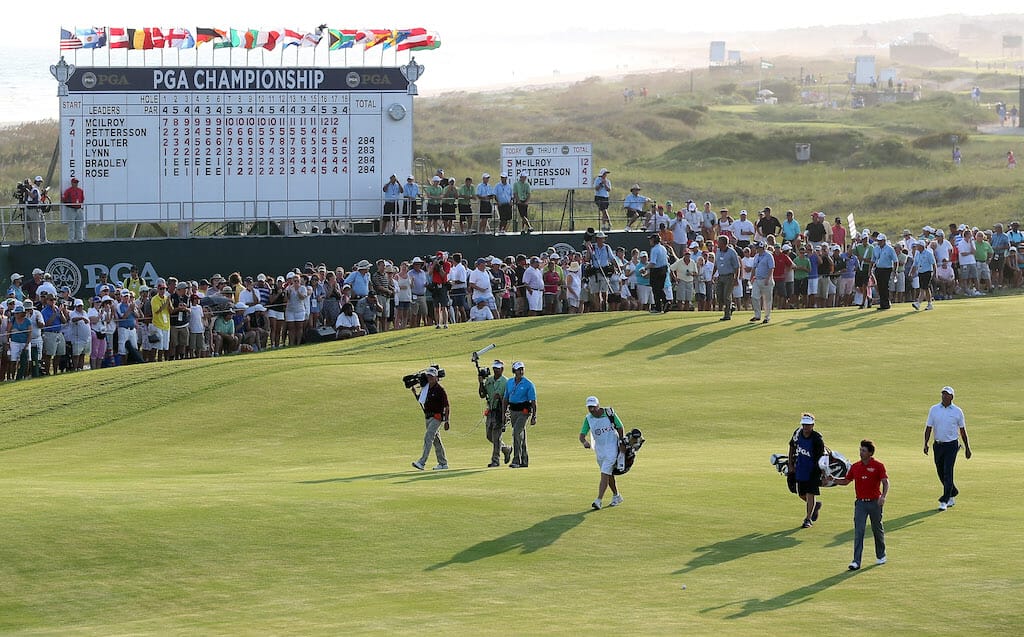- Kiawah Island was named for the Kiawah Indians who were led by their head chieftain or cassique. In the year 1670, the cassique of the Kiawah led English colonists to settle at Charlestowne Landing.
- Kiawah Island is an island of 15.14 square miles (39.21 Kms) with 11.17 square miles of land (28.23 Kms) and the rest water. The highest part on Kiawah Island is just 13-foot above sea level.
- The first golf course Cougar Point (formerly Marsh Point) was opened in 1976. The 1980s saw the opening of two of the seven golf courses associated with Kiawah-Turtle Point in 1981 and Osprey Point in 1988.
- Kiawah Island is home to five public golf courses including:
- The Ocean Course
- Osprey Point (Tom Fazio design)
- Cougar Point (Gary Player design)
- Turtle Point (Jack Nicklaus design)
- Oak Point (Tom Fazio design)
- The Ocean Course boasts the most seaside holes in the Northern Hemisphere with ten hugging the Atlantic Ocean and the other eight running parallel to those. Although it was originally planned to sit behind the dunes, designer Pete Dye’s wife, Alice, suggested raising the entire course to give players unobstructed views of Kiawah’s stunning coastline from every hole.
- The Ocean Course is a par 72 course and from the championship tees, it stretches to 7,849 yards (7,177 m) with a slope rating of 155 and a course rating of 79.1, the highest in the U.S., according to the United States Golf Association.
- It costs around $383 to tee-up on the Ocean Course and that doesn’t include a gratuity (Usually $100) for the services of a caddie. Though caddies are not compulsory. Golfers can use pull trolleys but there are none to rent.
- Kiawah Island’s first big taste of competition was the 1991 Ryder Cup – the infamous ‘War by the Shore’ taking place not long after the victorious Desert Storm war in the Middle East. Pro-Americanism was running high with USA Captain, Dave Stockton setting a mood by posing in a military-inspired photo/posted, leading to some American players turning-up on day one wearing battle-fatigues-inspired golf caps.
Sadly, the ‘war’ rhetoric fanned the flames for some unfortunate spectator behaviour, Team Europe players claimed, but the Americans said they were simply honouring troops taking part in Operation Desert Storm; the Europeans said some of the Americans’ actions crossed the line from patriotism to jingoism.
The 1991 Ryder Cup came down to the last match – Hale Irwin vs. Bernhard Langer, and reached the final green all square. Langer needed to win the hole to win the match and retain the Ryder Cup for Europe. Irwin needed to halve the match to win back the Cup for USA. Irwin struggled to get in the hole, Langer conceding him a short bogey putt. It left Langer 45-feet from the cup with two putts to win. But Langer ran his first putt six feet past the hole, and then, attempting to slide the ball past two spike marks, slid his par putt past the cup. A half-point for Team USA, a half-point for Team Europe – and a 14.5-13.5 victory for the Americans.
- In 1996, two of the great women golfers – Dottie Pepper and Annika Sorenstam – faced each other in the Shell Wonderful World of Golf series. Pepper won by two strokes shooting a 75 to Sorenstam’s 77.
- A year later in 1997 Padraig Harrington and Paul McGinley teamed to win the World Cup of Golf. Thirty-two teams teed-up with the Irish team in a class of their own winning by five shots with a 31-under par total and each winning $200.000. Scotland’s Colin Montgomerie won the ‘individual’ honours at 22-under par to earn an extra $100,000 with McGinley fourth and Harrington sharing fifth.
- The World Cup of Golf returned to Kiawah Island in 2003. Twenty-four nations were represented, including the Ireland side of Harrington and McGinley who’d reigned supreme six years earlier on the Ocean Course. However, it was theSouth African team of Rory Sabbatini and Trevor Immelman winning by four shots to split a whopping $1.4m first prize. The England side of Paul Casey and Justin Rose were runners-up. There was no individual prize.
- The 68th Senior PGA Championship was staged in 2007 at Kiawah with Zimbabwean Denis Watson posting a closing 68 to edge out struggling Argentinian Eduardo Romeo by two shots with Nick Price making it a first and third for Zimbabwe.
- At the 2012 PGA Championship, now referred to as ‘Glory for Rory’, Rory McIlroy made it two major championship titles in six majors in posting a closing round bogey-free 66 to win his second major title by eight strokes over runner-up David Lynn of England. The victory margin was a record for the PGA Championship, surpassing the seven-stroke win in 1980 by Jack Nicklaus for his fifth PGA and 17th major title. The winner of the U.S. Open in 2011, also by eight strokes, McIlroy became the sixth-youngest winner of two majors at 23 years and 3 months.
- David Lynn’s second place finish earned him a 2013 PGA Tour card and he would use his membership to finish runner-up that year in the Wells Fargo Championship but the two-time European Tour winner then dramatically quit tournament golf altogether at the end of 2014 having played 408 European Tour events. The now 47-year-old had already been accumulating properties with his prize-money, so much so, he is now head of Lynn Homes and currently has on the market a range of ‘affordable’ homes in rural Lincolnshire in England. Each is named after a famed UK golfcourses– Wentworth, The Belfry, Turnberry, Sunningdale and Muirfield.
- Bizarrely, after birdieing the first two holes on day three of the 2012 PGA Championship, Rory McIlroy’s tee shot on the drivable, par-4 third hole landed in a tree branch some 8-feet off the ground and in the middle of the fairway. McIlroy, his caddie and officials all searched for the ball, looking high and low, in tall grass and the surrounding area, but nothing turned up. TV coverage was able to determine that his ball had indeed come to rest in a hole in the branch. After being informed of this, McIlroy looked in the tree and saw the ball. From there, McIlroy took an unplayable lie but was able to save par after a tidy pitch shot. As he walked off the green, he grinned and disposed of the uncooperative ball. The tree withstood being hit so many times by golfers and had endured strong winds and hurricanes but it was a disease that ultimately killed this tree in 2015. In 2019, the course planted a replacement oak that resembled “Rory’s tree,” which preserves the strategy and overall visual appeal of the hole. For the next century and beyond, golfers will still be able to pass by the tree and marvel at the contrast between its bare body and the idyllic seaside ensemble it inhabits.
- Rory McIlroy wore two shirts on the final day of the 2012 PGA Championship. Strong winds on day three forced officials to call a halt to play with McIlroy playing just nine holes. The closing nine holes of the third round was played on Sunday morning with McIlroy wearing a white shirt. He returned for the final round having changed into a red shirt. Tiger Woods, who shared 11th place and 11 shots adrift of McIlroy, wore his own traditional red shirt for the entire day. McIlroy was asked during his winner’s conference about changing into a red shirt: “I thought if I was playing with Tiger, I wouldn’t wear it but I wasn’t so I wore a red shirt. Obviously him, you know who him is (smiling). It was in the script that Oakley (Then sponsoring McIlroy) sent me at the start of the week. If I was going to be paired with Tiger today (Fourth round), I wasn’t going to wear red. I remember what happened to Luke Donald in 2006 at Medinah. I wasn’t playing with him and thought I would wear it. Might have to do it from now on; no wonder he wins so much (laughing).” McIlroy has continued to wear, at times, in a final round including winning the 2012 DP World Tour Championship and 2019 RBC Canadian Open.
- Rory McIlroy returns to Kiawah Island to tee-up in what will be a 49th career major championship. It had taken McIlroy 11 majors to win a first (2011 US Open), 17 to win two (2012 PGA Championship), 24 to capture three (2014 Open Championship and 25 to win a fourth (2014 PGA Championship). He’s since competed in 23 majors with a best finish T2nd at the 2018 Open.
- Could 13 still be Rory McIlroy’s major championship lucky number? This week will be McIlroy’s 13th appearance in the PGA Championship and matches 13 appearances in the Masters. He will tee-up in a 13th US Open next month and then in July contest a 13th Open Championship.
























Leave a comment